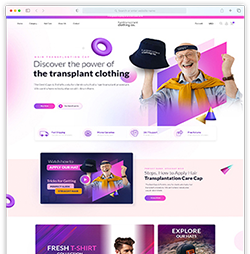
We Love to hear you back
Contact US
HR Department




.png?width=732&height=428&name=A-Beginners-Guide-to-HubSpot-Website-Template-Design%20(1).png)
Creating an effective and visually appealing website is crucial for any business looking to establish a strong online presence. HubSpot, a leading customer relationship management (CRM) platform, offers robust tools for building and customizing website templates. This guide will walk you through the basics of HubSpot website template design, providing you with the knowledge to start creating beautiful and functional templates that meet your business needs.
"HubSpot website templates" are pre-designed layouts that you can customize to create your website. These templates are built using HubSpot's drag-and-drop editor, making it easy for users with little to no coding experience to design professional-looking websites. Templates include various elements such as headers, footers, content sections, and modules that you can easily modify.

Set Up Your HubSpot Account
Before you start designing, you need to set up a HubSpot account. If you don't have one, visit the HubSpot website and sign up for a free or paid account based on your business needs.
Access the HubSpot CMS
Once your account is set up, navigate to the HubSpot Content Management System (CMS). Here, you can access the template marketplace, your existing templates, and the drag-and-drop editor.
Choose a Template
HubSpot offers a variety of pre-built templates in its marketplace. Browse through the available options and choose one that aligns with your business goals and design preferences. You can filter templates based on industry, style, and functionality.
Customize Your Template
.webp?width=732&height=390&name=Customize-Your-Template%20(1).webp)
With your template selected, it's time to make it your own. Here are some key elements you can customize:
Preview and Test
Before publishing your template, preview it to ensure it looks and functions as expected. Test your template on different devices (desktop, tablet, and mobile) to ensure it is responsive and user-friendly.
Optimize for Speed
Website speed is crucial for user experience and SEO. To ensure fast load times, optimize images, use efficient code, and leverage HubSpot's built-in performance tools.
Implement Analytics
Integrate HubSpot's analytics tools to track your website's performance. Monitor metrics such as page views, bounce rates, and conversion rates to understand how visitors interact with your site.
Publish Your Website
Once you're satisfied with your design, it's time to publish your website. HubSpot makes this process straightforward, allowing you to go live with just a few clicks.

Keep It Simple
Simplicity is key to a good design. Avoid clutter and focus on clean, straightforward layouts that guide the user's eye naturally through the content.
Focus on User Experience (UX)
Ensure your website is easy to navigate. Use clear headings, concise text, and intuitive navigation menus. The user experience should be smooth and enjoyable.
Optimize for SEO
Incorporate SEO best practices into your template design. Use relevant keywords, optimize images with alt text, and ensure your site loads quickly.
Use High-Quality Visuals
High-quality images and videos can make a significant difference in the overall look and feel of your website. Ensure all visuals are professional and relevant to your content.
Test Regularly
Regular testing and updates are essential to maintaining a high-performing website. Use HubSpot's analytics tools to monitor your site's performance and make necessary adjustments.
Leverage Personalization
Use HubSpot's personalization features to create dynamic content that changes based on the visitor's behavior and preferences. This can significantly improve user engagement and conversion rates.
Incorporate Clear CTAs
Ensure your calls to action are clear and compelling. Place them strategically throughout your website to guide users towards desired actions, such as signing up for a newsletter or making a purchase.
Maintain Consistent Branding

Consistency in branding across your website reinforces your brand identity. Use the same color schemes, fonts, and imagery that align with your overall brand strategy.
Accessibility
Ensure your website is accessible to all users, including those with disabilities. Follow web accessibility guidelines to make your site more inclusive and user-friendly.
Keep Content Fresh
Update your website content regularly to keep it relevant and engaging. Fresh content can help improve SEO rankings and keep visitors coming back for more.
Use A/B Testing
Conduct A/B testing to compare different versions of your pages and determine which design elements perform best. This data-driven approach helps optimize your site for better results.
Designing a HubSpot website template design doesn't have to be daunting. With its intuitive tools and robust features, even beginners can create stunning and functional websites. By following this guide and incorporating best practices, you'll be well on your way to building a website that not only looks great but also supports your business goals. Happy designing!


If you want to convert traffic into real leads, then optimizing the local search for your business is the ideal tool...
You should initially decide to pick a platform for operating your website if you plan on starting an online business...